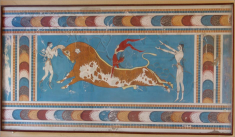Speaker
Description
The Borromean rings, a type of topological link, and the quantum GHZ state share a common feture. Cutting out or removing one of the components in the Borromean rings leaves the two others unlinked. Analogously, tracing out the Hilbert space of one of the subsystems in the GHZ yields a separable state. Aravind, Kauffman and others put forward the question if such an analogy may be used to map quantum states in a way similar to graph states. The relation between topological linking and quantum entanglement is an interesting concept in its own right; One may wonder what would be the quantum mechanical analog of topological equivalence of knots and links. In this work, we present some new results connecting topological linking and entangled quantum states. In particular, we construct a quantum state analog of the Brunnian links, of which the Borromean rings is the simplest case.The newly constructed states have the property of becoming uncorrelated upon tracing out any one of the subsystems.
Our approach relies on a unique representation of number partitioning — the problem of determining whether or not a set of integers may be partitioned into two subsets having the same sum. This problem is sometimes referred to as the easiest NP-complete problem for having a pseudo-polynomial time dynamic programming solution. The idea is to construct a n- partite quantum state based on a set of n integer numbers, which is necessarily entangled if the set of numbers admit a balanced partitioning, and is uncorrelated otherwise. The distinguished feature of the Brunnian links may, at that point, be readily translated into number partitioning: a set of numbers admitting a balanced partitioning of which the subsets have no partition. The Borromean rings, for instance, may correspond to a state encoded by the set {1,2,3}. Indeed, this set has a balanced partition, {1,2} and {3}. Removing any one of the numbers from this set yield the subsets {1,2}, {1,3}, or {2,3}, none of which have a partition. Similarly, the 4-component Brunnian link corresponds to {2,3,4,9}. Our scheme for constructing the mentioned quantum states shows that the Brunnian linking property may be translated into partitioning which may be further translated into quantum entanglement, or concisely written: topological linking —-> balanced partition exists —> entangled state, and unlink —-> unbalanced partitioning —-> uncorrelated state.
We discuss the implications of this new construction in the context of topological quantum information.
References:
P. K.Aravind, Borromean entanglement of the GHZ state. in ‘Potentiality,Entanglement and Passion-at-a-Distance”,ed.by R.S.Cohenetal,p p.53-59, Kluwer,1997.
Louis H Kauffman and Samuel J Lomonaco Jr, Quantum entanglement and topological entanglement, 2002 New J. Phys. 4 73
Details
Dr. Avishy Carmi,
Faculty of Engineering and
Center for Qauntum Science and Technology, Ben-Gurion University, Israel
| Is this abstract from experiment? | No |
|---|---|
| Name of experiment and experimental site | N/A |
| Is the speaker for that presentation defined? | Yes |
| Internet talk | No |
